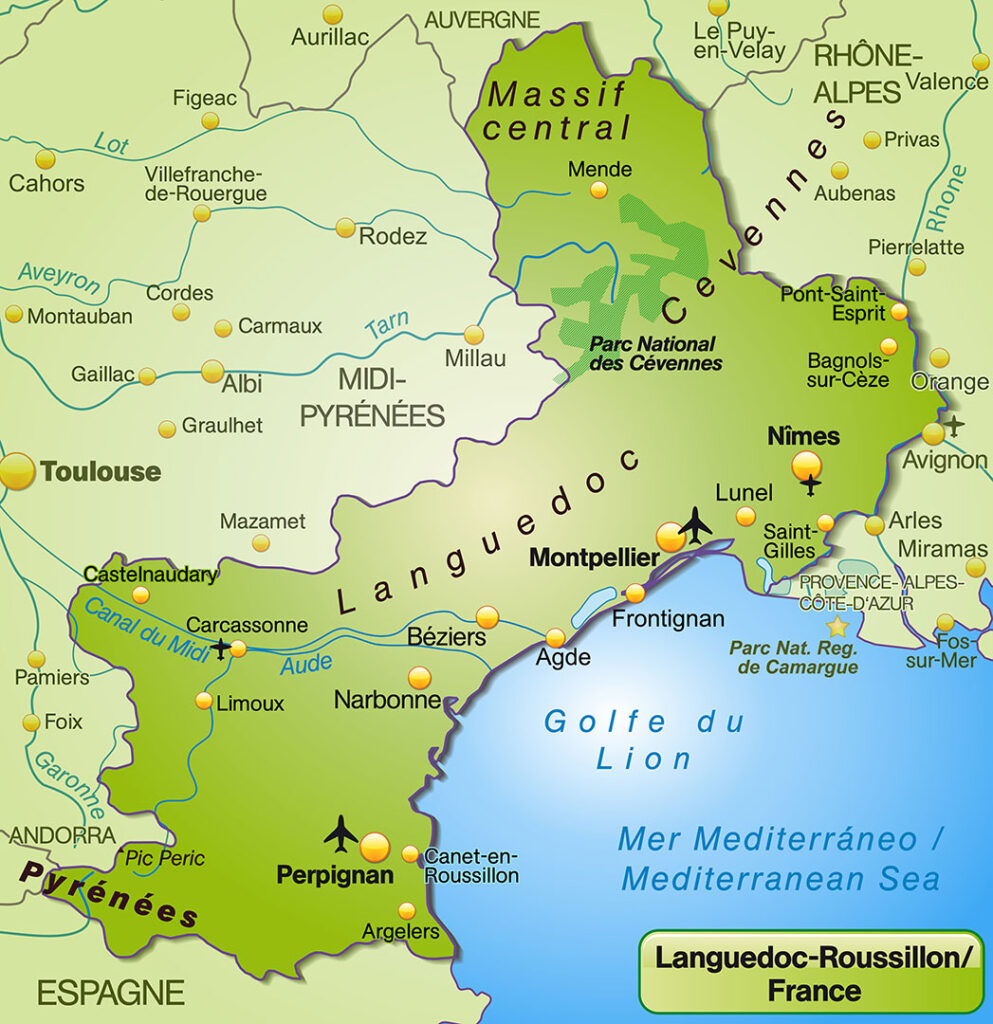This website uses cookies so that we can provide you with the best user experience possible. Cookie information is stored in your browser and performs functions such as recognising you when you return to our website and helping our team to understand which sections of the website you find most interesting and useful. For more information you can visit our Privacy Policy page.







The Languedoc
Stretching along the Mediterranean from the Cote d’Azur in the east to the Spanish border in the south, the Languedoc-Roussillon is often referred to as the ‘real’ South of France. Rolling vineyards fringed with cypresses, medieval castles and ruins atop craggy hills, fragrant olive groves, endless beaches, historic cities and atmospheric villages make up the landscape of this hidden gem. This quintessentially French region, more widely known as just ‘Languedoc’, boasts several World Heritage sites, including La Cité in Carcassonne and the Pont du Gard in Avignon. And through the middle of it all the tranquil and remarkable Canal du Midi, another World Heritage site, weaves its sedate way from the Atlantic, through Toulouse and Narbonne, to the Mediterranean coast at Sete.
The region is made up of 5 departments, namely, Pyrenees Orientales the southernmost department, Aude, Herault, Gard, the easternmost and Lozére, the northernmost. The geography of the Languedoc is diverse and varied. Its coastline in the main is flat, other than a short stretch between Perpignan and the Spanish border (La Côte Vermeille). Additionally, in many places Languedoc offers two coastlines: one adjacent to the sea itself, and another further inland along the shores of the area’s many inland salt water lagoons or ‘etangs’. The fertile inland plains are dominated by gently rolling hills made up of vineyards and the local ‘garrigue’ (a perfumed scrub of broom, rosemary, lavender, euphorbia and other dry-weather plants), traversed by the Canal du Midi, whilst to the north, the landscape gives way to the rugged terrain of the Haute Languedoc, a less populated, mountainous region. This beautiful and varied countryside remains largely unspoilt. There are olive trees, Mediterranean oaks, and almond and cherry trees in the hills and traditional avenues of plane trees line many roads and the Canal du Midi, which provide shaded tunnels from the heat of the summer. Heading north into the hills, the vines and garrigue give way to forests of pines. From many vantage points there are spectacular views of the coast or across to the snow-capped Pyrenees.
The food, wine and cuisine of the Languedoc are no less spectacular. Good food and good wine is an essential part of life for the people of Languedoc. Work stops for a couple of hours at lunchtime as colleagues or family get together to share a meal. Eating is an extremely sociable affair and meals often last for several hours as people chat while enjoying the various courses. Specialities in the region include seafood platters of clams, oysters and mussels from coastal villages of the Etangs; Pélardon, Causses Blue and Tomme cheeses; Tielle (seafood pie) from Sete; cherries from Ceret; Picholine and Lucques olives and much, much more.
Naturally a glass or two of wine often forms part of any meal. Languedoc is currently one of the most interesting wine-making regions in the world and its huge range of wines is now widely acknowledged by critics. Times have changed and during the last ten years quality has started to take priority over quantity. Vineyards have been replanted with more interesting grape varieties as adventurous wine makers buy up vineyards and offer wines blended in more novel ways. Passionate wine makers from South Africa, Australia, UK, America and other parts of France are converging on the region to create wines of great subtlety and complexity.
The Languedoc is full of history. The area has some of France’s most spectacular and interesting historical sites including prehistoric fortified hill top settlements, such as L’Oppodium d’Ensérune, the crumbling remains of Cathar castles and the elegant cloisters of medieval abbeys. La Cité in Carcassonne is the world’s largest medieval castle and France’s second most visited sightseeing attraction after the Eiffel Tower. Many Roman ruins are to be found in the region, like the section of the old Roman road ‘Via Domitia’ which ran from Rome to Spain, dating from around 118 B.C, unearthed in the centre of Narbonne in 1997.
With 300 days of sunshine and plenty to occupy all ages and stages, the Languedoc is now one of the most popular holiday destinations in France. A growing tourist industry and ever improving transport links have resulted in a property boom since the late 1990s. With relatively affordable prices, the region is becoming increasingly popular with local and international buyers alike, who flock here for the glorious climate, relaxed lifestyle and great wines!
Our properties are mainly to be found in the zone stretching from Beziers in the east, to the Corbieres in the west, the Minervois in the north and to the Mediterranean coast in the south. We focus particularly on the villages bordering or close to the magical Canal du Midi and the sophisticated city of Narbonne.
To view details of all properties currently available please visit www.pullenfrance.com/properties


